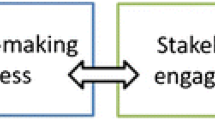Abstract
This paper proposes a reformulation of the concept of rationality in public policymaking. Following Lindblom's critique, it accepts that “comprehensive rationality” is unfeasible as a practical policymaking strategy, but suggests that a slightly recast concept could provide a suitable “ideal criterion” for the assessment of policymaking strategies. Adopting this “limited rationality” criterion, a variant of the “mixed scanning strategy” emerges as a basic prescription for the conduct of public policymaking, the paper provides a pair of case studies (in the field of transportation) to illustrate the need for mixed scanning.
Similar content being viewed by others
References
Albrow, M. (1970). Bureaucracy, London: Pall Mall Press.
Arrow, K. J. (1951). Social Choice and Individual Values, New York, Wiley (1st ed.); (1954, 2nd ed. revised).
[Bendixson, T. (1974). Instead of Cars, London: Temple Smith.
Beneveniste, G. (1973). The Politics of Expertise, London: Croom Helm.
Braybrooke, D. and Lindblom, C. E. (1963). A Strategy of Decision: Policy Evaluation as a Social Process, Free Press: New York.
Coates, J. (1973). in New Scientist, 24 May, p. 466.
Coates, J. (1975). “Technology Assessment at the NSF,” in S. R. Arushin and A. Christakis, eds., Perspectives in Technology Assessment, Jerusalem: Science and Technology Publishers.
Dahl, R. A. and Lindblom, C. E. (1953). Politics, Economics and Welfare, New York: Harper.
Dror, Y. (1964). “Muddling Through—‘Science’ or Inertia?”, Public Administration Review, 24; 153–163.
Dror, Y. (1968). Public Policymaking Reexamined, Scranton, N.J.: Chandler.
Dror, Y. (1971). Decision for Policy Sciences, New York: Elsevier.
Etzioni, A. (1968). The Active Society, New York: Free Press.
Evans, T. (1973). “Nottingham as a Working Class City,” Lecture given at Strathclyde University, Glasgow, 9th February (mimeo).
Francis, R. G. and Stone, R. C. (1956). Service and Procedure in Bureaucracy, Minneapolis: University of Minnesota Press.
Gerth, H. H. and Wright Mills, C. (1948). (trans. and eds.) From Max Weber, London: Routledge and Kegan Paul.
Gouldner, A. W. (1955). Patterns of Industrial Bureaucracy, Chicago: University of Chicago Press.
Hamilton, W. F. (1974). Impact of Future Use of the Electric Car in the Los Angeles Region, Santa Barbara: General Research Corporation.
Harvey, D. C. and Menchen, W. R. (1974). The Automobile—Energy and the Environment, Columbia, Maryland: Hittman Associates.
Hillman, M., Henderson, I. and Whalley, A. (1973). Personal Mobility and Transport Policy, London: P.E.P.
Hillman, M., Henderson, I. and Whalley, A. (1976). Transport Realities and Planning Policy, London: P.E.P.
Hoffman, G. (1969). “Future Electric Automobiles,” Technological Forecasting, 1: 173–174.
Hoos, I. (1971). Systems Analysis in Public Policy, London: University of California Press.
Lindblom, C. E. (1959). “The Science of Muddling Through,” Public Administration Review, pp. 79.
Lindblom, C. D. (1965). The Intelligence of Democracy: Decision-Making Through Mutual Adjustment. Free Press: New York.
Little, A. D. (1968). Prospects for Electric Vehicles, U.S. National Centre for Air Pollution Control, May.
March, J. G. and Simon, H. E. (1958). Organizations, New York: Wiley.
Merton, R. K. (1940). “Bureaucratic Structure and Personality,” Social Forces, XVII: 560–568; also in Merton, (1952), pp. 361–371.
Moynihan, D. P. (1969). Maximum Feasible Misunderstanding: Community Action in the War Against Poverty, New York: Free Press.
Podgorecki, A. (1976). “Social Technology and Decision Making,” in A. Cherns, (ed.), Sociotechnics, London: Malaby Press.
Schultze, C. L. (1968). The Politics and Economics of Public Spending, Washington: Brookings.
Self, P. (1972). Administrative Theories and Politics, London: Allen and Unwin.
Selznick, P. (1949). TVA and the Grassroots, Berkeley: University of California Press.
Sills, D. L. (1957). The Volunteers, New York: Free Press.
Simon, H. E. (1947). Administrative Behavior, New York: Macmillan, (1st ed.); (1957, 2nd ed.).
Trench, S. and Slack J. A. (1974). “Nottingham's New Transport Policy,” Traffic Engineering and Control, December.
Wilensky, H. L. (1967). Organizational Intelligence, New York: Basic Books.
Author information
Authors and Affiliations
Rights and permissions
About this article
Cite this article
Gershuny, J.I. Policymaking rationality: A reformulation. Policy Sci 9, 295–316 (1978). https://doi.org/10.1007/BF00136832
Issue Date:
DOI: https://doi.org/10.1007/BF00136832




